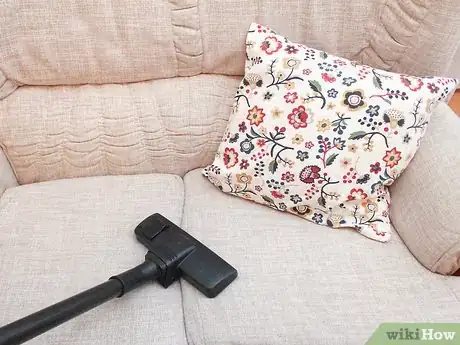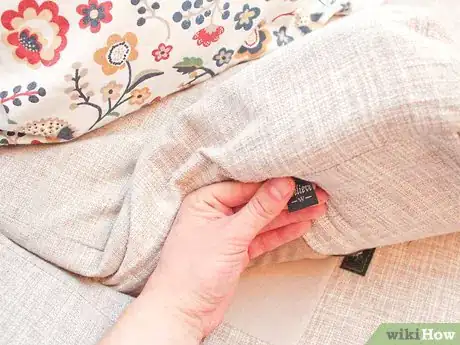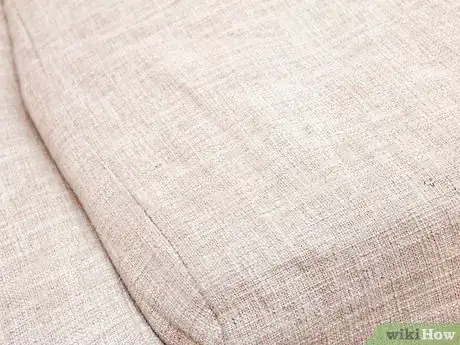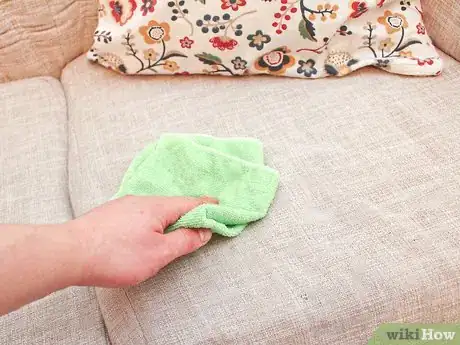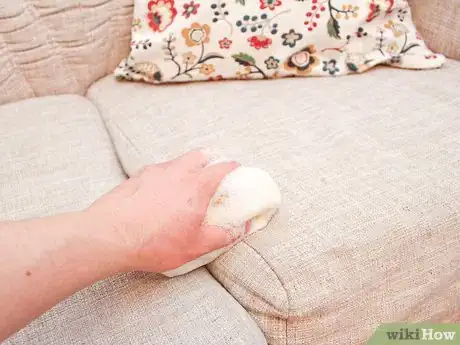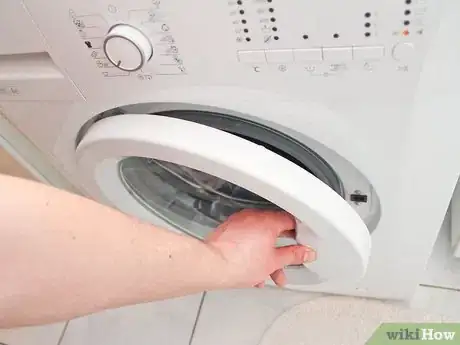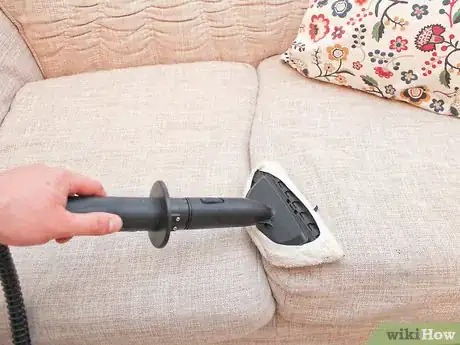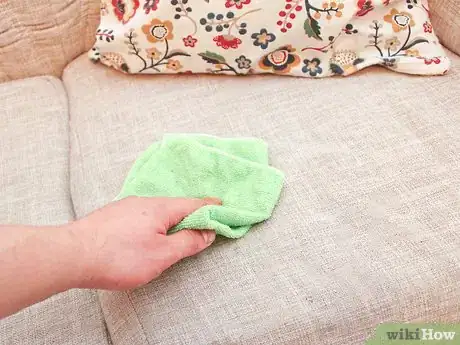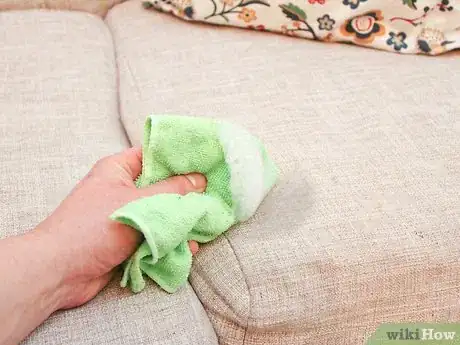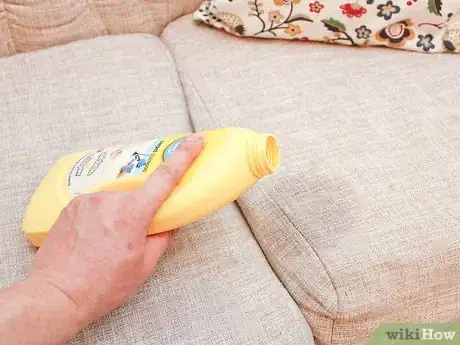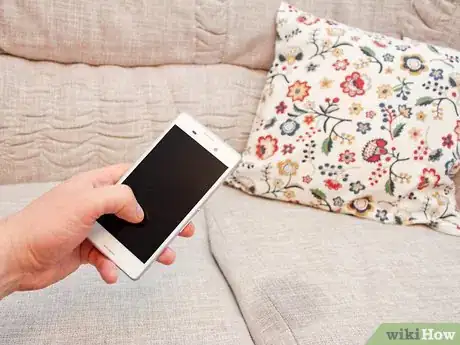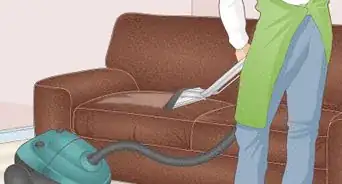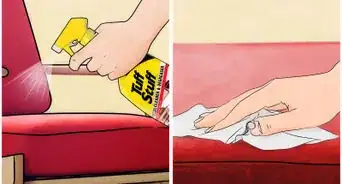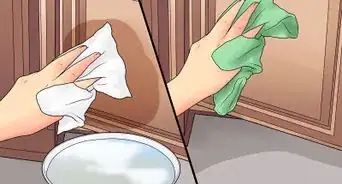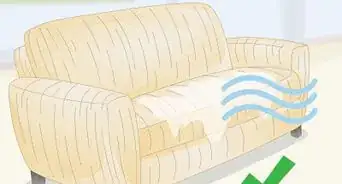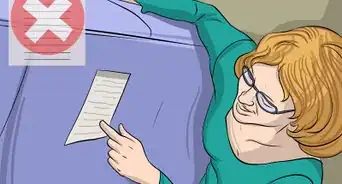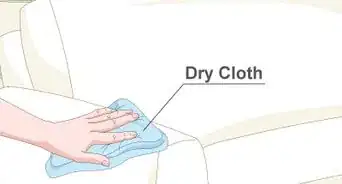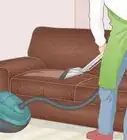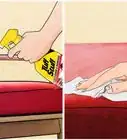This article was co-authored by Ashley Matuska. Ashley Matuska is a Professional Cleaner at the Founder and Owner of Dashing Maids in Denver, Colorado. Ashley has over seven years of experience in the cleaning industry. She and her team specialize in offering sustainable deep cleaning and maintenance cleaning services.
There are 7 references cited in this article, which can be found at the bottom of the page.
This article has been viewed 38,849 times.
Dirtiness and blemishes can be glaringly obvious on white furniture. Regular cleaning will keep your furniture in the best condition and remove stains that appear. Prep to clean the white upholstery of your furniture by vacuuming it and verifying its safe cleaning recommendations. Remove general dirtiness by spot cleaning as the need arises and wiping furniture down with soapy water. Tackle stubborn stains with a white vinegar, specially formulated cleaners, or a professional cleaning service.
Steps
Prepping White Upholstery for Cleaning
-
1Vacuum the furniture to prevent ingraining loose dirt and debris. Use a soft brush attachment to protect the fabric while cleaning.[1] Pay close attention to gaps, corners, nooks, and crannies. Dirt and debris often accumulate in these places.
- Using wet cleaning measure before vacuuming can cause loose dirt and debris to become ingrained in the fabric, making it more difficult to clean.
- Removing loose debris from your furniture will make it easier to find and remove stains. Light stains often hide underneath thin layers of dust.[2]
-
2Verify the safe cleaning recommendations for the furniture. Some furniture may be damaged by certain cleaners or methods of cleaning. Check the tag on your furniture to learn which cleaners and methods to avoid. In the event your tag is damaged or lost, look up this information online.
- For example, when cleaning leather furniture, you should avoid using water. Use steam cleaners or specially formulated leather cleaning solutions instead.
- Abbreviations on the furniture tag, called “cleaning codes,” indicate how to safely clean dirty furniture. The most common of these are:
- W: clean with a water based cleaner.
- S: use a waterless cleaner, like a dry cleaning solvent.
- WS: use either a water based cleaner or a waterless product.
- X: vacuum and brush the furniture, but only use a professional service otherwise.[3]
Advertisement -
3Inspect stains, if necessary. Some stains, like those from coffee, red wine, and blood, may require special treatment to remove. If you do not know the source of the stain, examine its shape and color to try and determine its cause.[4]
- Before cleaning stains generally accepted as difficult to remove, like coffee, red wine, and blood, look up the proper cleaning procedure online to prevent yourself from accidentally ingraining it in the fabric.
Removing General Dirtiness
-
1Spot clean as the need arises. Wipe spots gently in a blotting motion with baby wipes. If you don’t have baby wipes, similarly clean spots with a clean microfiber cloth dampened with cool water and a small amount of mild laundry detergent mixed together.
- Always test cleaning agents on an out of sight part of your furniture before cleaning visible sections. If the fabric is discolored or negatively impacted by the cleaner, refrain from using it.
- In most cases, the cleaning agents in baby wipes will be gentle enough to clean your furniture without damaging it.
- When spot cleaning, refrain from soaking the fabric all the way through. This could cause the quality of the fabric to deteriorate.[5]
EXPERT TIPAshley Matuska is a Professional Cleaner at the Founder and Owner of Dashing Maids in Denver, Colorado. Ashley has over seven years of experience in the cleaning industry. She and her team specialize in offering sustainable deep cleaning and maintenance cleaning services.Professional Cleaner
 Ashley Matuska
Ashley Matuska
Professional CleanerStart with plain water, then move to cleaning agents if necessary. Ashley Matuska of Dashing Maids says, "When you're cleaning white furniture, just use a microfiber towel and warm water to see if you can get the stains out without using any detergent or chemicals. If not, the next best thing is warm water, dish soap, and a microfiber towel. If that's not quite enough, try a mild all-purpose cleaner."
-
2Wipe upholstery with soapy water for general cleaning. Fill a bucket with cool water. Add a small amount of dish soap. Stir the water until bubbles form. Wet a clean microfiber cloth in the solution. Wring out excess water. Lightly wipe the furniture to clean its fabric.[6]
- Avoid over saturating the fabric of the furniture when cleaning in this fashion. Only a light to moderate amount of water should soak into the furniture fabric.
- While wiping the furniture, follow the natural grain (direction) of the fabric. Going against the grain could damage its appearance.
-
3Clean removable covers in a washing machine, if applicable. The machine wash instructions for your furniture should be listed on its label. Use a cold cycle and an appropriate amount of detergent. Avoid machine washing too frequently, as this can sometimes cause fabric to break down more quickly.[7]
- If your label has fallen off or is impossible to read, look up machine washing instructions by searching for the furniture name and manufacturer online.
- Unless otherwise indicated, do not dry your furniture covers in a dryer. Doing so may cause the quality of your fabric to deteriorate.
- For an even higher quality cleaning, take your furniture covers to a dry cleaner. Dry cleaning information should be indicated on the furniture’s label.
-
4Use a steam cleaner. Some fabrics used in white furniture, like leather, shouldn’t be exposed to water if it can be helped. Water can stain or damage these kinds of fabrics. A steam cleaner is usually an effective and safe upholstery cleaning tool in these cases.
- The operation of your steam cleaner will depend on its make and model. Follow the instructions that came with your steam cleaner for best results.
- For small areas that need additional cleaning power, use the “Steam” function of an iron to apply a burst or two of steam before using general cleaning measures.[8]
-
5Allow furniture to air dry completely after cleaning. Air drying is the gentlest way of removing moisture from furniture fabric. Position the cleaned furniture somewhere it won’t be touched and re-dirtied. Some furniture may take up to 48 hours to dry.[9]
- In some cases, you may need to repeat certain techniques, like wiping the fabric with cool, soapy water, several times before dirt is fully removed.
- To prevent the furniture from being over saturated with water, allow it to dry completely after applying each cleaning technique.
- Speed up the drying process by opening windows. Though the natural drying option is always best, you could also speed up drying by blowing on wet spots with a hairdryer.[10]
Tackling Stains
-
1Eliminate stubborn stains with white vinegar or vodka. Target stains that remain after spot cleaning or general cleaning with undiluted white vinegar or vodka. Similar to spot cleaning, dampen a clean microfiber cloth with vinegar or vodka and blot the stain. Do not over saturate the fabric.
- Although the smell of vinegar and vodka may be strong when first applied, when these liquids dry the smell should disappear.[11]
-
2Apply a baking soda paste for coffee and wine stains. These kinds of stains can be removed from many fabrics with a thin layer of paste made from a small amount of baking soda and water. Cover the stain completely with the paste. Wait five minutes, then blot the paste from the fabric with a clean, water dampened microfiber cloth.[12]
- After the majority of the wine stain has been removed, use a general cleaning measure to remove anything that remains.
-
3Remove blood stains from your furniture. Dampen a microfiber cloth with mild hand soap or dish soap and cold water. Lightly work this mixture into the stained fabric in a blotting motion. With a clean microfiber cloth dampened with cold water, blot the stain to remove the soap. When the stain has faded, wash the fabric as you would normally.
- Avoid applying heat to blood and other protein stains, as it will usually make them more difficult to remove.
- In some cases, you might not be able to clean blood stains that have set in the fabric of the furniture.
- For severe stains, you may need to use soap and cold water several times before the stain fades sufficiently. Allow the fabric to dry naturally in between applications.[13]
-
4Use a suitable upholstery cleaner on remaining stains. Specially formulated upholstery cleaner can be found at most general retailers, like Walmart and Target, and hardware stores. Each cleaner will be different, so you should use it according to its label directions.[14]
- Read the usage instructions of cleaners carefully before purchasing them. Some may be intended for certain fabrics or stains.
- Some upholstery cleaners may use harsh chemicals that can break down the fabric of your furniture if used too often.
-
5Repeat cleaning measures as necessary. You may need to repeat general cleaning measures after the fabric dries from its upholstery cleaner treatment. If the stain remains after the second round of general cleaning, allow the fabric to dry and repeat the upholstery cleaner treatment. Repeat this process as necessary.[15]
-
6Call a cleaning professional. Professional furniture cleaners have tools and techniques that allow them to remove dirtiness from deep inside the fabric. Schedule a professional cleaning for your furniture about once a year to keep your white furniture in the best condition.
- If your furniture is especially old or valuable, to prevent accidental damage, you may want to only use a professional service.
- When a professional cleaner visits, ask them about ways you can maintain and clean your furniture on your own.[16]
Warnings
- Color may transfer from your cleaning cloth to your furniture. For this reason, cloths that are colored should be tested on out of sight locations on the furniture first. Prioritize clean, white, microfiber cleaning cloths.⧼thumbs_response⧽
- Avoid rubbing or scrubbing motions when cleaning the fabric of white furniture. This may cause pilling or fabric deterioration.⧼thumbs_response⧽
- Cleaning agents with abrasives can damage the fabric of your furniture. Avoid these to maintain its condition.⧼thumbs_response⧽
Things You’ll Need
- Baby wipes
- Bucket
- Microfiber cloth (white preferred)
- Mild laundry detergent
- Vacuum (with attachments)
- Vodka (optional)
- White vinegar
References
- ↑ https://www.cleanipedia.com/gb/furniture-upholstery/how-to-clean-a-sofa-and-remove-stains-from-furniture
- ↑ https://www.bondcleaninginmelbourne.com.au/how-to-Clean-upholstered-furniture/
- ↑ http://www.stain-removal-101.com/how-to-clean-upholstery.html
- ↑ https://www.apartmenttherapy.com/tips-on-how-to-spot-clean-old-or-setin-stains-on-upholstery-208738
- ↑ https://www.cleanipedia.com/gb/furniture-upholstery/how-to-clean-a-sofa-and-remove-stains-from-furniture
- ↑ https://www.cleanipedia.com/gb/furniture-upholstery/how-to-clean-a-sofa-and-remove-stains-from-furniture
- ↑ https://www.cleanipedia.com/gb/furniture-upholstery/how-to-clean-a-sofa-and-remove-stains-from-furniture
- ↑ https://www.apartmenttherapy.com/tips-on-how-to-spot-clean-old-or-setin-stains-on-upholstery-208738
- ↑ https://www.overstock.com/guides/how-to-clean-a-white-sofa
- ↑ https://www.cleanipedia.com/gb/furniture-upholstery/how-to-clean-a-sofa-and-remove-stains-from-furniture
- ↑ https://www.apartmenttherapy.com/tips-on-how-to-spot-clean-old-or-setin-stains-on-upholstery-208738
- ↑ https://www.overstock.com/guides/how-to-clean-a-white-sofa
- ↑ https://www.cleanipedia.com/gb/laundry-washing/removing-blood-stains-from-clothes
- ↑ http://www.howtocleanthings.com/furniture/how-to-clean-upholstery/
- ↑ https://www.apartmenttherapy.com/tips-on-how-to-spot-clean-old-or-setin-stains-on-upholstery-208738
- ↑ http://www.stain-removal-101.com/how-to-clean-upholstery.html
About This Article
To clean white furniture, wipe it down with a microfiber cloth dampened with water and dish soap. If you need to remove stains, blot the area with baby wipes, or with a soft cloth dampened with cold water and mild laundry detergent. For stubborn stains, blot with undiluted white vinegar or vodka. Alternatively, cover the stain with a paste of baking soda and water, then wipe off the paste after 5 minutes with a damp microfiber cloth. After cleaning, let the furniture air dry for up to 48 hours. For more advice, including how to clean furniture that can’t be exposed to water, keep reading!
